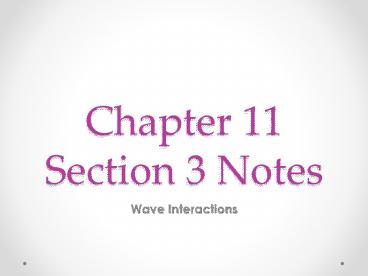Chapter 11 Section 3 Notes - PowerPoint PPT Presentation
1 / 17
Title:
Chapter 11 Section 3 Notes
Description:
Chapter 11 Section 3 Notes Wave ... they bend because of a change in wave speed. Interference ... You hear a pattern of alternating loud and soft sounds, ... – PowerPoint PPT presentation
Number of Views:94
Avg rating:3.0/5.0
Title: Chapter 11 Section 3 Notes
1
Chapter 11 Section 3 Notes
- Wave Interactions
2
Reflection
- Reflection the bouncing back of a wave as it
meets a surface or boundary. - Example When light hits a shiny bumper it
reflects back off of it.
3
Reflection
- When a boundary is free to move, the reflected
wave is exactly like the original wave.
4
Reflection
- When a boundary is fixed (doesnt move), the
reflected wave is like the original, but turned
upside down and travels in the opposite
direction.
5
Diffraction
- Diffraction the bending of a wave as it passes
an edge or opening.
6
Diffraction
- Example A person standing in a hallway is able
to hear voices coming from a classroom because
the sound waves bend as they pass the opening of
the door.
7
Refraction
- Refraction the bending of waves as they pass
from 1 medium to another
8
Refraction
- The waves reflected from the bottom of the spoon
reach your eyes from a different angle than the
waves at the top of the spoon.
- Example A spoon in a glass of water looks bent
because of refraction. The light waves bend as
they pass from the air to the water to your eyes.
Each time the waves enter a new medium, they bend
because of a change in wave speed.
9
Interference
- Interference the combination of 2 or more waves
that exist in the same place at the same time and
result in a single wave
10
Interference
- Constructive Interference any interference in
which waves combine so that the resulting wave is
larger than the original wave. - Diagram of constructive interference
11
Interference
- Destructive Interference any interference in
which waves combine so the resulting wave is
smaller than the largest of the original wave. - Diagram of destructive interference
12
Interference of Light Waves
- Why do bubbles have a swirling rainbow effect?
- Some waves bounce off the outside of the bubble
and travel directly to your eye, while other
waves travel into the thin shell of the bubble
and bounce off the inner side of the bubbles
shell, then back through the shell, air, and your
eye. At times, the 2 sets of waves are out of
phase with each other. They interfere
constructively at some frequencies (colors) and
destructively at other frequencies (colors).
13
Interference of Sound Waves
- When compressions from 2 sound sources arrive at
your ear at the same time, constructive
interference occurs and the sound is louder. - A short time later, a compression from one source
and a rarefaction from the other arrive together,
destructive interference occurs and a softer
sound is heard. - You hear a pattern of alternating loud and soft
sounds, called beats.
14
Standing Waves
- Standing Waves a wave caused by interference
that appears not to move along the medium and
that shows some regions of no vibration (nodes)
and other regions of maximum vibration (antinodes)
15
Standing Waves
- Nodes Points that have no vibration
- They are located at points where crests of
original waves meet the troughs of reflected
waves - Antinodes Point that have maximum vibrations
- They are formed where crests of original waves
line up with crests of reflected waves and
constructive interference occurs
16
Standing Waves Diagram
17
Key Ideas
- What happens when a wave meets an object?
- What happens when a wave passes into another
medium? - When a wave meets a surface, the wave bounces
back. That is called REFLECTION. - When a wave passes the edge of an object or
passes through an opening, the wave bends. That
is called DIFFRACTION. - A wave also bends when it passes from one medium
to another at an angle. That is called
REFRACTION.































